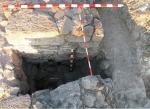Summary (English)
DEULTUM (Lyudmil Vagalinski – lvagalin@techno-link.com) An area of 261 sq. m was explored. A fortification tower with trapezoid plan was discovered on Late Antique northern fortification wall. It was projected at 8.48 m in front of the fortification wall and was 11.86 m long. The front walls of the tower were 2.20 m wide and the side back walls were 1.60 m wide. The walls were built of cut stones, including spolia from the Roman period, with courses of bricks at some places, with a core structure of roughly-cut stones and fragmentary building ceramics bonded with mortar. The first two floors of the fortification tower with stone walls were preserved. The upper part of the tower was constructed of sun-dried bricks. A staircase built of stones was discovered, leading to the upper floors. The fortification tower had two embrasures on its northern front wall and one embrasure on each side wall. Two more embrasures were explored at the adjacent fortification wall to the west of the tower. The tower was burnt and roof-tiles malformed from the strong fire were found. The discovered fortification of Deultum belonged to the newly-constructed Late Antique fortress, built in the second half of the 5th century AD (after AD 457) and burnt after AD 527, judging from the latest coin discovered in the layer with debris minted in AD 527 – 538. This northern peripheral part of Deultum was occupied during the 7th – 8th centuries AD as well. The finds from the excavations included weaponry and 37 Late Antique copper and bronze and one silver coins.
- Lyudmil Vagalinski - Archaeological Institute with Museum
Director
Team
Research Body
- Archaeological Institute with Museum






![Download [PDF]](/excavation/skins/fasti/images/results/download_sml.png)

